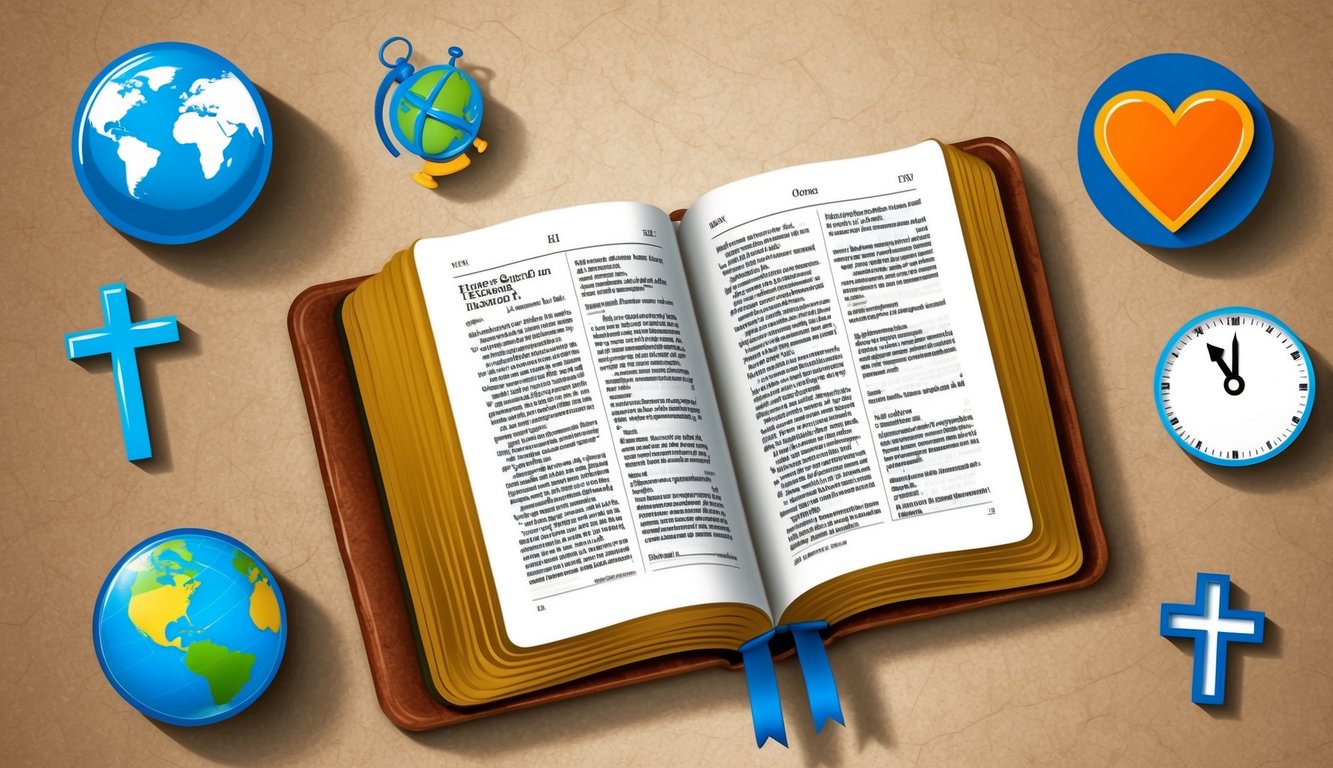Don’t Miss Out On This Unique Astrological Opportunity
Are you tired of spinning your wheels and getting nowhere? Simply put, you’re out of sync: you’re out of alignment with your astral configuration.
But: there’s a kind of map that can help you reclaim your alignment. Think of it as your own personal blueprint to success and happiness: a blueprint that will help you live your most amazing life.
Get started here.
Choosing to follow a Bible reading plan can deepen your faith and understanding of scripture.
A structured plan helps you stay organized and ensures you explore all parts of the Bible.
This may be difficult if you’re reading on your own.
Whether you prefer a chronological journey or thematic study, various plans cater to different needs and interests.
Using a Bible reading plan can enrich your spiritual practice.
Access to tools like audio versions, daily reminders, and progress trackers can make your reading schedule more manageable.
Online platforms and apps provide numerous options suited for different lifestyles.
If you’re new to Bible reading plans or looking for a fresh approach, there are many resources available online.
These include printable charts, podcasts, and devotionals.
Engaging with these resources can create a more meaningful and immersive reading experience.
Key Takeaways
- A Bible reading plan helps organize and enhance your study.
- Resources like apps and audio versions offer convenient support.
- Online materials provide diverse ways to engage with scripture.
Creating Your Bible Reading Plan
Creating a Bible reading plan involves understanding the types of plans available, setting goals, and selecting the right Bible translation.
These steps will help you create a habit of daily readings and stick with it throughout the year.
Understanding Different Types of Plans
Bible reading plans come in various formats.
Some are designed to guide you through the entire Bible in a year, offering daily readings.
Others focus on specific sections, like the New Testament or the Gospels, over shorter time frames.
Chronological plans present events in the order they happened, providing a historical perspective.
You might also find plans focusing only on weekends or certain books.
Choose a plan that aligns with your schedule and interests.
Setting Realistic Goals
When setting goals, consider how much time you have each day for reading.
A plan that is too ambitious might be hard to follow, so start with something manageable, like a chapter a day.
Setting realistic goals helps build discipline and makes it easier to maintain the habit.
You can also use tools to track your progress, which can provide encouragement as you see your achievements over time.
Choosing the Right Translation
Choosing the right Bible translation can greatly affect your understanding and enjoyment of the text.
Popular choices include the NIV (New International Version) and ESV (English Standard Version).
When picking a translation, consider factors like readability and language style.
Compare a few passages in different translations to see which resonates with you.
Your choice should enhance the clarity and depth of your reading experience, helping you stay engaged with your plan.
Exploring the Books of the Bible
When exploring the Bible, it’s a good idea to start with a plan that shows you connections and themes.
The Old Testament, New Testament, and books of wisdom each offer something special for your journey.
The Old Testament Journey
The Old Testament is a collection of books that lays out the history and faith of the Israelites.
Beginning with Genesis, it tells the story of the Israelites’ history and faith. Exodus follows with the story of Moses leading his people out of Egypt.
These narratives are more than just tales—they’re about faith, courage, and reliance on God.
Besides stories, you find laws and guidelines in books like Leviticus and Deuteronomy.
The journey gives you insights into how ancient communities lived and worshiped.
You also meet prophets who share God’s messages, urging people to stay faithful.
Exploring these books helps you understand the foundation of biblical beliefs and the rich history of faith.
These texts reveal the moral and ethical principles that guided daily life, shaping traditions that still influence many today.
Studying them alongside a bible dictionary for scripture can provide deeper context, helping to clarify historical meanings and cultural significance.
Through this exploration, you gain a greater appreciation for the enduring wisdom found in these sacred writings.
The Teachings of the New Testament
The New Testament opens with the Gospels: Matthew, Mark, Luke, and John.
These accounts tell about Jesus’s life and teachings.
They’re heartwarming stories of love, sacrifice, and redemption.
You then have the Acts of the Apostles, which details the early church’s growth after Jesus ascended to heaven.
The Epistles, letters written by apostles like Paul, offer guidance and encouragement to early Christians.
They teach about the moral life and devotion, addressing churches and individuals.
Finally, Revelation provides a vision of hope, with vivid imagery and promises about the future.
This section of the Bible is all about spreading the good news and living a life of faith.
Wisdom Books and Poetry
Wisdom literature, including books like Psalms and Proverbs, offers insight and advice for daily life. Psalms is a collection of poems and songs, expressing a wide range of emotions from joy and gratitude to sorrow and seeking help.
These writings are often used in prayer and worship.
Proverbs gives practical tips on how to live wisely and make good choices.
You’re encouraged to seek knowledge and understanding.
Other books, like Ecclesiastes and Job, tackle life’s challenging questions, prompting reflection on purpose and suffering.
This section of the Bible invites you to pause and ponder, offering timeless messages wrapped in poetic language.
Integrating Thematic and Chronological Studies

Exploring the Bible through thematic and chronological lenses offers a structured way to engage with its teachings. Chronological studies let you experience the unfolding of history from Genesis to Revelation, while thematic studies enhance understanding by focusing on key themes and events like Easter or Advent.
Following The Biblical Timeline
When you follow the Bible in chronological order, you gain a sense of history and context.
This approach begins with the creation story in Genesis and traces through major events and teachings up to the prophecies and revelations found toward the end of the Bible.
Experiencing the Bible as a continuous narrative helps to piece together how different parts of Scripture relate across time.
Notably, when historical context is grasped, stories resonate deeper, showing how Biblical events connect to prophecy and fulfillments over time.
Engaging with events in their historical sequence aids in recognizing the cause-and-effect relationships throughout the Bible.
A chronological study fosters a comprehensive view where you see how plans and prophecies unfold across hundreds of years, from the historical accounts to the prophetic writings.
Thematic Reading for Deeper Understanding
A thematic Bible reading plan groups scriptures by themes or topics rather than following the order of the books.
This approach allows you to study one area in depth, like investigating what the Bible says about love, forgiveness, or significant holiday themes such as Christmas and Easter.
Focusing on themes helps to spot recurring messages and ideas across both the Old and New Testaments.
For example, exploring themes like redemption can highlight passages across different books that may not be adjacent to each other chronologically but are unified thematically.
Thematic studies are valuable for deepening understanding of specific Biblical concepts.
By probing into a particular theme, you gain insights that weave through the Bible, helping to grasp complex ideas and see their importance across various scriptures.
Supplemental Tools and Resources

To enhance your Bible reading plan, consider using various tools and resources.
They can offer support and make your experience more engaging.
Digital apps, study Bibles, and community discussions can each play a valuable role.
Digital Apps and Online Resources
Digital apps can make Bible reading accessible and convenient. YouVersion is a popular app with many reading plans like the Navigators Bible Reading Plan and Book-at-a-Time Bible Reading Plan.
Each plan offers a different focus to fit your needs.
The app includes features like reminders and sharing options to help keep your routine on track.
Other online platforms, like the BibleProject, offer reading plans and animated videos that can enhance your comprehension of scripture.
Whether you want to read the entire Bible or focus on the New Testament with plans like the 5x5x5 New Testament Bible Reading Plan, these digital resources are readily available and user-friendly.
Study Bibles and Companion Books
Study Bibles can be invaluable for deeper understanding.
They often include footnotes, maps, and context that highlight key verses.
Companion books can introduce topics or themes relevant to your reading.
Companion books often pose questions that encourage thoughtful reflection, challenging you to see scripture in new ways.
These resources can be found in most bookstores or online, making it easy to find versions tailored to your needs.
They also provide background information that can enhance your grasp of biblical events and teachings.
Community Groups and Discussions
Participating in community groups enriches your Bible study by offering different perspectives.
Small groups often meet regularly to discuss specific passages or topics, providing a supportive environment where questions are encouraged.
Online forums and social media groups are also excellent options for engaging discussions.
These platforms offer a chance to connect with others who share your interest in the Bible, making your study both an enlightening and interactive experience.
Such discussions can provide encouragement and motivation, aiding you in sticking to your reading plan.
Frequently Asked Questions

Finding the right Bible reading plan can help you start and stay consistent.
Whether you’re new or have specific goals like reading the Bible in a year, there’s a plan that can fit your needs.
What is a good Bible reading plan for someone just starting out?
If you’re new to reading the Bible, a great starting point is a plan that breaks the text into manageable sections.
Consider plans that focus on major stories and themes to help you get acquainted with the Bible’s structure and message.
The 3-Track Reading Plan in the NIV Student Bible is a popular choice.
How can I find a Bible reading plan that fits my schedule?
Flexibility is key when choosing a plan to match your lifestyle.
Look for options like the Six Day Bible Reading Plan, which offers flexibility and convenience.
To find the perfect fit, consider whether you want to read daily, weekly, or focus on specific topics or sections.
Are there any chronological Bible reading plans available?
Yes, chronological plans present the Bible’s events in the order they occurred, which can provide new insights.
For example, chronological plans re-order books like Jeremiah to reflect historical timelines.
Many publishers offer these plans, allowing you to read the Bible as a continuous narrative.
Is it possible to read the Bible in one year, and if so, how?
Reading the entire Bible in one year is possible with plans designed for daily reading.
These plans break the text into daily segments, and some focus on specific themes or sections each day.
Fr.
Mike Schmitz’s “Bible in a Year” podcast offers structured guidance to help you achieve this goal.
Can I get a free Bible reading plan in PDF format online?
Many websites offer free PDF versions of Bible reading plans.
Simply search online and you’ll find a variety of options to download and print.
Whether you prefer linear reading or thematic studies, there are many free resources to help you start immediately.
How does the 5x5x5 Bible reading plan work?
The 5x5x5 plan is tailored for those short on time.
It involves reading five days a week, focusing on five minutes of reading per day, which can typically cover one chapter.
This plan includes options for deeper reflection and allows flexibility, making it a fantastic option for beginners or busy individuals.



